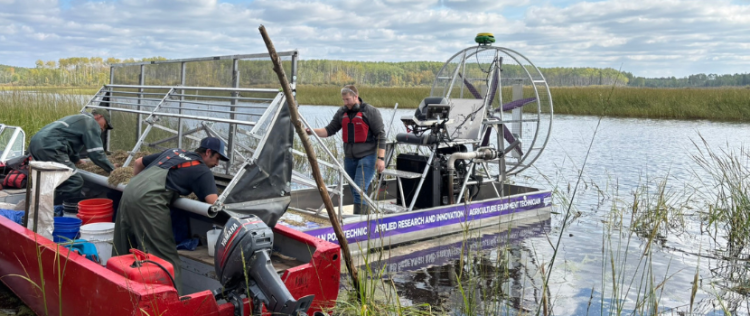Saskatchewan Polytechnic faculty have flexed their agriculture, engineering and fabrication expertise to develop a new design for a wild rice harvester.
For the past three years, the applied research project team has focused on modernizing equipment for partner NWC Wild Rice Company's Indigenous producers in northern Saskatchewan. This one-of-a-kind prototype may lead to a future manufacturing facility for NWC.
Chris Thomson, program head of Sask Polytech's Agricultural Equipment Technician (AET) program, is technical lead for the wild rice harvester prototype project. Known for his work with combines and tractors, Thomson has turned his agriculture expertise to wild rice, a crop that requires specialized equipment to harvest from shallow lakes and marshes.
Traditional wild rice harvester boats are small airboats circa the 1980s powered by recreational motors, which are prone to failure, costly to replace and difficult to repair. The new prototype boats are custom-designed and built by Sask Polytech for wild rice harvesting, using industrial-grade components that are more economical and easier to maintain.
"Everything on the boat is custom and we have been able to increase harvesting efficiencies and productivity by 100 per cent" says Thomson. "In one pass, the boats harvested six bags of rice, double the usual yield. Fuel economy also improved by 100 per cent. It's great news for Saskatchewan wild rice harvesters and NWC Wild Rice Company."
"Indigenous innovation is transforming Prairie agriculture," says the Honourable Eleanor Olszewski, Minister of Emergency Management and Community Resilience and Minister responsible for Prairies Economic Development Canada. "By combining traditional knowledge with new technology, projects like this wild rice harvester are creating opportunity, advancing economic reconciliation, and building stronger communities across northern Saskatchewan."
"I know how important the wild rice industry is to families and communities across northern Saskatchewan. It's not just a job; it's a tradition and a source of pride," says the Honourable Buckley Belanger, Secretary of State (Rural Development). "This partnership between Saskatchewan Polytechnic and NWC Wild Rice Company is about building on that. By bringing new technology to the craft, we're helping northern harvesters cut costs, work safer, and keep a way of life alive for the next generation."
"Building these prototype wild rice harvesters has been a collaborative effort between program disciplines at Sask Polytech," says Dr. Larry Rosia, Sask Polytech president and CEO. "Faculty from AET, Machinist and Welding programs have shared their expertise, along with researchers from Sustainability-Led Integrated Centres of Excellence (SLICE) in our Research in Additive Manufacturing and Prototyping facility. This project's great success is the result of strong internal collaboration and the invaluable knowledge from Indigenous harvesters."

When the project wraps up in December of this year, Sask Polytech will have produced three prototype boats. These are expected to replace aging models from the 1980s that have become obsolete due to unavailable parts and outdated designs.
The boats feature custom-built hulls, redesigned propulsion systems and precision agriculture technology adapted from farm equipment. Each is powered by a 4.3-litre V6 industrial emission-controlled engine, selected after evaluating more than 25 manufacturers for durability and serviceability in northern conditions.
The precision agriculture equipment uses GPS to follow precise paths, reducing overlap and missed areas. "We incorporated telematics from traditional farming equipment to track speed and position in the wild rice patch," Thomson says. "It's more than GPS it's precision farming for wild rice, bringing the same data-driven approach used in large-scale farming to this smaller, specialized crop."
Quintin Dudragne, an AET instructor at Sask Polytech, has been working full time on the project for two years. He designed a collapsible and removable header system for the boat that mimics a combine header, allowing for easy transport and repair in remote and rural areas in northern Saskatchewan.
Dudragne says, "The entire boat was designed and built on the idea for sustainable repairs. Every component can be removed for service using basic tools and training by the final consumer. My career as an agricultural mechanic and being the son of a farmer has showed me the need for this in the agriculture industry."
The boats were tested in harvesting conditions for the first time in September near Beauval, where producers from Canoe River and Île-à-la-Crosse took them out on the water. Previous testing wasn't possible due to wildfires and insect damage that hindered the wild rice harvest in the region in previous years. The Sask Polytech team was uncertain how the prototypes would perform, however the results far exceeded expectations.
"The harvesters were excited with the results of the new boat design in the wild rice fields," says Celine Favreau CEO of NWC Group of Companies. "It performed well - proving it will improve their harvesting capacity, reduce their costs, and introduce technological advancements to the harvest. Thanks to the support of PrairiesCan and Sask Polytech for the opportunity to partner in this initiative. This project supports our work to secure a more engaged economic future for our Indigenous shareholder communities in this thriving land-based industry that is important to our region."
Community engagement has been central to the project. Sask Polytech traveled north to consult with local harvesters four times throughout the project and incorporated expert local knowledge into the design. Early in the project one respected wild rice producer Emile Burnouf provided a modified boat design that served as the foundation for further innovation.
"We have had great engagement with the communities near Beauval and listened to their advice and feedback," Thomson says. "This project is a step towards economic reconciliation in agriculture. There's never been funding to modernize wild rice equipment and we saw no reason our ag program couldn't help."
NWC Wild Rice Company now owns the intellectual property for the prototype boats and hopes to establish a manufacturing facility in the Beauval region. Sask Polytech will continue to offer technical advice and collaboration.
"These are prototype boats, but they're already making a difference," Thomson says. "The community is excited and we've shown that with the right expertise and collaboration, we can support Indigenous communities and help make wild rice harvesting safer, more productive and more sustainable."
The project is partially funded by $400,000 from PrairiesCan. The applied research project is a partnership between Sask Polytech's SLICE and NWC Wild Rice Company, an Indigenous-owned enterprise based in northern Saskatchewan.
Learn more at about applied research and SLICE at saskpolytech.ca/slice.










